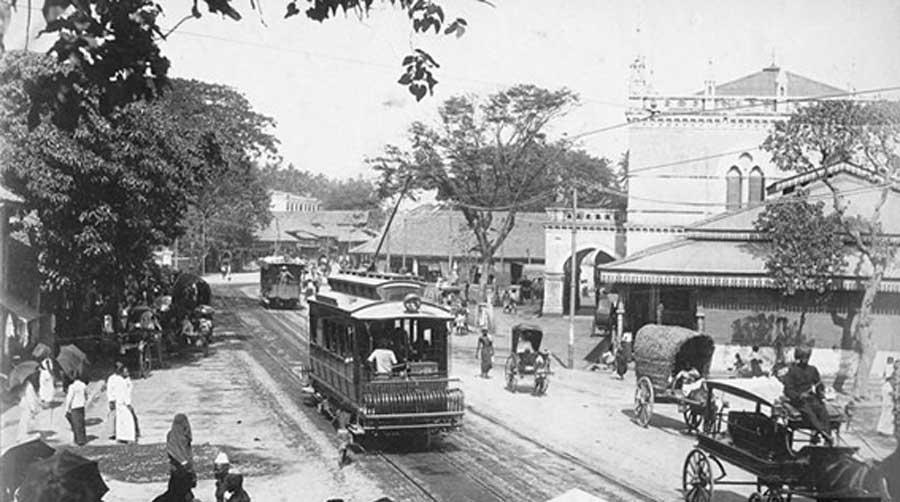Reply To:
Name - Reply Comment

Tramcar on gas works street in 1910
Walking down the sparsely crowded Norris Road to my office at Fort 54 years ago, I noticed two street urchins discovering silver under a layer of molten tar on the road. Hidden underneath the tarred road  which first appeared as bar of shinning metal, their ‘lucky strike’ was part of a track on which the tramcars that conquered City’s roads, carrying commuters for over five decades used to roll. There are a few visible tram lines near the Old Town Hall at Dias Place. Tramcars a milestone in the history of city’s transport system, a milestone that has since been uprooted in the name of modernity.
which first appeared as bar of shinning metal, their ‘lucky strike’ was part of a track on which the tramcars that conquered City’s roads, carrying commuters for over five decades used to roll. There are a few visible tram lines near the Old Town Hall at Dias Place. Tramcars a milestone in the history of city’s transport system, a milestone that has since been uprooted in the name of modernity.
“Strictly speaking there are no roads in the island…”, -- Rev. James Cordiner, Chaplain to Colombo Garrisons in 1807.
Plight of Colombo light rail transit
Colombo Light Rail Transit (LRT) project the government have now completely pushed out of existence after the President had a meeting with the engineers and the relevant officers who thought that this was a waste of resources. A Chinese firm undertook a feasibility study in November 2017 and its report was submitted in June 2018. The total estimated cost of this project which was to be implemented by Ministry of Megapolis and Western Development was US$ 6 billion; and the then government approved the public-private partnership project. The first phase which included the construction of a 15.8 km stretch between Fort and Malabe with 16 stations was estimated to cost US$2.2 billion, and was planned to commence in 2020. The four-car formation with a maximum passenger capacity of 800, equipped with a rooftop air conditioning system will run at an average speed of 70 km/h. Japan International Corporation Agency (JICA) was to offer US$1.8 billion as a loan on repayment term of 40 years on behalf of the Japanese Government. Colombo LRT project was expected to reduce traffic in the city, and also reduce the carbon imprint of the country. Initiated by Patali Champika Ranawaka, the LRT project report has been dumped in the waste bin.
On Sep 16, 1845, the Ceylon Herald reported,
“British enterprises are changing the face of the earth; but great projectors are often turn mad—it is a maxim in political economy that heavy goods can be conveyed by canal at less cost than by any other means..”; the result being on October 2, 1865, a train carrying 84 passengers in 10 carriages began its historical journey from Colombo to Ambepussa.
Early rail transport
Long before Railways, “Tramways” existed in the world. Coal mining in the mineral districts of England in the late 16th Century, tramways became essential. World’s first rail track was constructed between Darlington and Stockton, a 64-km railway was inaugurated in September, 1825. The Ceylon Railway Company – (CRC) formed in October 1845 commenced work on Colombo-Kandy line on August 3, 1858.
Tramcars - first self-powered omnibus
Motor cars were unknown then, there was no kind of public transport in the city apart from Rickshaws, horse carriages and buggy carts used by the elite— when the British Mayor, Colombo Municipal Council called for proposals in 1892 for the construction of tramways in the city, two engineering companies, Boustead Brothers and Whittall and Co, [Whittals were the company that introduced Man-powered Rickshaws to Ceylon in 1883], responded. A contract was signed between CMC and Boustead in 1895. Overhead construction, laying the tracks, and the construction of power station commenced in September 1897. A track-laid for a vehicle that runs on it along public urban streets termed electric street railways. Tramcars use electrical power, usually fed by a pantograph sliding on an overhead line. The earliest models were of a ‘toast rack’ styled, skeletal appearance and a more open design, later models were with a cladding to match the times.
In the early days of the bus service and before, the tramcars were the sole beast of burden that carried the city’s traffic. They converged on two main routes— In January 1900, Ceylon Electric Tramways opened the country’s first tramway service with the ‘Grand Pass Route’ first to open, followed by Borella/Maradana Route. Tramcars were a milestone in the history of the city’s transport system. Later it was taken over by a Colombo Municipality. The constant fear of tramcar drivers, like their successor trolleys were the frequent power failures.
"Colombo LRT project was expected to reduce traffic in the city, and also reduce the carbon imprint of the country. Initiated by Patali Champika Ranawaka, the LRT project report has been dumped in the waste bin."
Tramcars also loom large in the history of the labour movement of Ceylon, for it was the first time that an organized show of strength led to violence in 1920s. From the time the service was started with the influx of people into the city after the WW II, the trams were able to comfortably handle the transport problem of crowded Metropolis. The early models of the trams were open cars with rows of parallel seats which were ‘directional’. The tram would speed one way and when the journey’s end was reached the seats folded over at the backrest and the passengers would then seat themselves facing the new route taken. There was also a seat at each end screened from the main body of the car which was first class, reserved for Europeans! The Pettah Power Station was used to power the tramcar network. The track on both routes was re-laid with 95 lb rails between 1905 and 1907, with joints being welded by thermite process.
The Depot was near the Gas Works next to the Pettah Power Station. Turning right it went past the Railway Station, Lower Chatham Street alongside the CTO and the Chamber of Commerce, turn right on to York Street near the Registrar General’s Office, passed Bristol Hotel,Cargills, Apothecaries, National Bank, and ended near the Grand Oriental Hotel. The open tramcars provided a happy-hunting ground for pickpockets who really went to town on these vehicles. In the late 1950s, the CMC decided to do away with tramways, the tram network was eventually scrapped in 1960, and replaced, a decade later with double-decker trolley buses, which also powered by electricity on a long arm fixed on to the roof linked to the electricity lines like in the tramcars that powered their ‘soundless’ motors, but soon found them economically ‘unsound’ as well and closed down on January 1, 1965.
It is a tragedy that CMC failed to retain and preserve a single vehicle as a monument in its museum for the future enthusiasts before they ended up at Colombo 12’s scrap-yards, in spite of the fact, in entire South Asia, Colombo was the first city to own a tramway. They say the cars were auctioned by them for Rs.120 each and were purchased by buyers of surplus steel and iron in Panchikawatte.